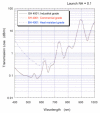Intensity-Modulated Polymer Optical Fiber-Based Refractive Index Sensor: A Review
- PMID: 35009621
- PMCID: PMC8747346
- DOI: 10.3390/s22010081
Intensity-Modulated Polymer Optical Fiber-Based Refractive Index Sensor: A Review
Abstract
The simple and highly sensitive measurement of the refractive index (RI) of liquids is critical for designing the optical instruments and important in biochemical sensing applications. Intensity modulation-based polymer optical fiber (POF) RI sensors have a lot of advantages including low cost, easy fabrication and operation, good flexibility, and working in the visible wavelength. In this review, recent developments of the intensity modulation POF-based RI sensors are summarized. The materials of the POF and the working principle of intensity modulation are introduced briefly. Moreover, the RI sensing performance of POF sensors with different structures including tapered, bent, and side-polished structures, among others, are presented in detail. Finally, the sensing performance for different structures of POF-based RI sensors are compared and discussed.
Keywords: different structures; intensity modulation; polymer optical fiber; refractive index sensing.
Conflict of interest statement
The authors declare no conflict of interest.
Figures


















References
-
- Zhang Y.-N., Sun Y., Cai L., Gao Y., Cai Y. Optical fiber sensors for measurement of heavy metal ion concentration: A review. Measurement. 2020;158:107742. doi: 10.1016/j.measurement.2020.107742. - DOI
-
- Yan X., Li H., Su X. Review of optical sensors for pesticides. TrAC Trends Anal. Chem. 2018;103:1–20. doi: 10.1016/j.trac.2018.03.004. - DOI
Publication types
MeSH terms
Substances
Grants and funding
LinkOut - more resources
Full Text Sources

